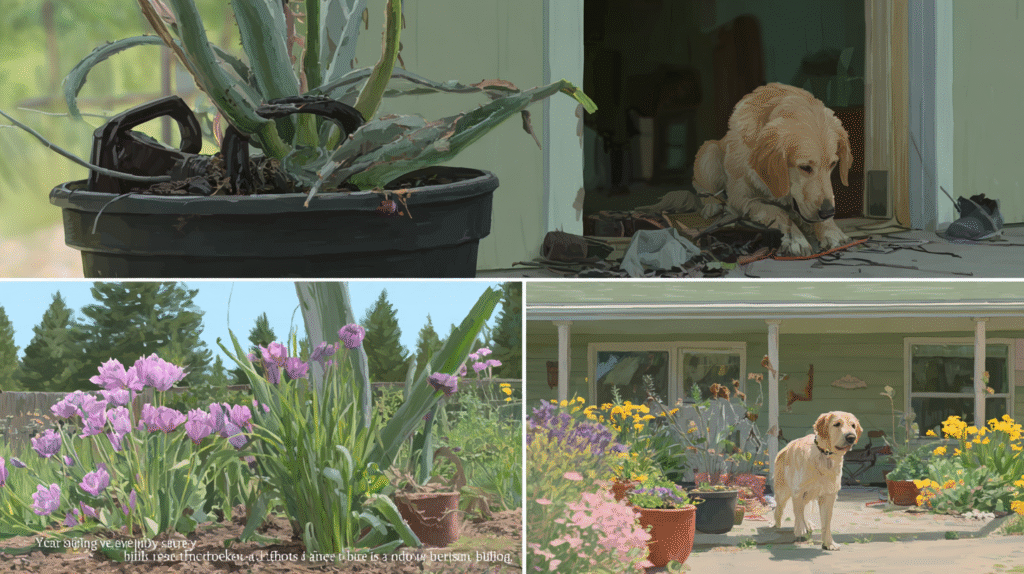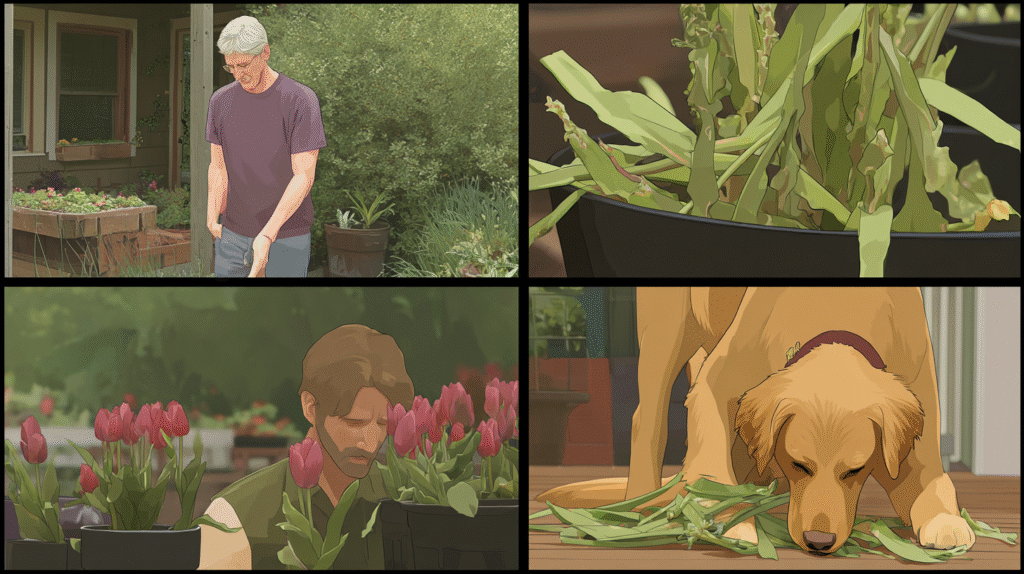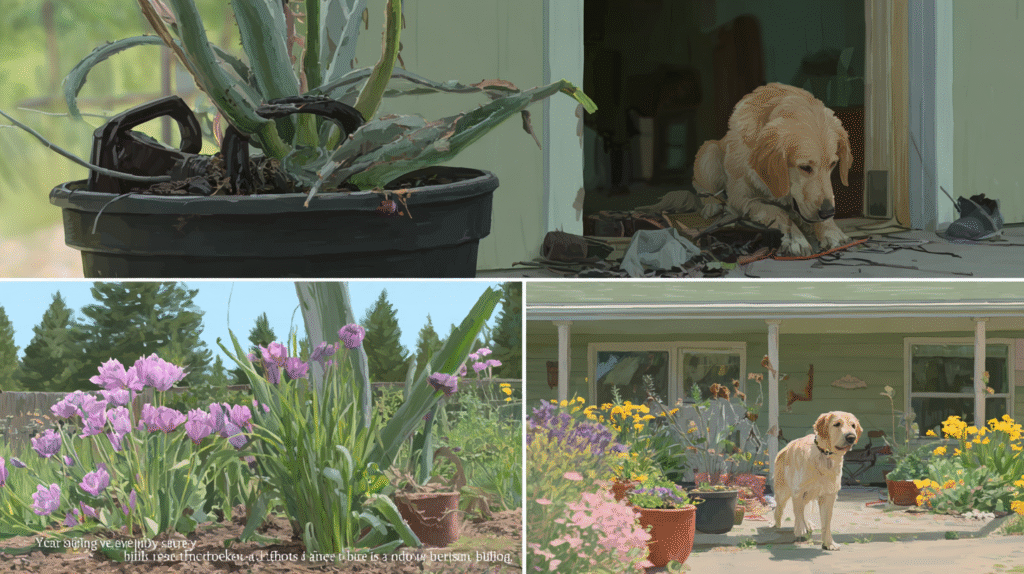The vet’s words still echo in my head: “Ten more minutes and we might’ve lost her.”
It was a sunny Saturday morning when my golden retriever, Bailey, started vomiting in the kitchen. Within an hour, she was trembling, drooling, and could barely stand. The culprit? A sago palm I’d planted the week before, thinking it would add a “tropical vibe” to our backyard.
That $40 plant resulted in a $3,000 emergency vet bill and the worst 48 hours of my life. But it also taught me a lesson I’m desperate to share: most of us have no clue which common plants can kill our dogs.
The Morning That Changed Everything
I’d been so proud of my backyard makeover. New mulch, fresh plants from Home Depot, and that gorgeous sago palm as the centerpiece. Bailey had been out there for maybe twenty minutes while I made coffee.
When she came in, she seemed fine. Then the vomiting started. Then the shaking. By the time I googled “sago palm toxic to dogs,” my hands were trembling as badly as hers.
Every part of that plant is poisonous, but the seeds are basically death pellets for dogs. And I’d planted it right where Bailey loved to explore.

The Deadly Dozen: Common Plants That Can Kill Your Dog
After Bailey’s near-death experience, I went full research mode. Turns out, my yard was basically a toxic wasteland. Here are the most dangerous plants to dogs that might be in your space right now:
1. Sago Palm (The Silent Killer)
- Every part is toxic, seeds are the worst
- Causes liver failure, often fatal
- Symptoms show up fast – within 15 minutes to a few hours
- Even with treatment, survival rate is only 50%
2. Oleander
- One leaf can kill a large dog
- Affects the heart immediately
- Common in Southern landscaping
- Even the water in a vase with oleander is toxic
3. Azaleas and Rhododendrons
- Just a few leaves cause serious problems
- Vomiting, drooling, potential coma
- Super common in suburban yards
- The honey made from these flowers is even toxic
4. Lily of the Valley
- Those cute little bell flowers are deadly
- Causes heart problems and seizures
- Often in shady garden spots
- Can be fatal even in small amounts
5. Autumn Crocus
- Not your spring crocus – this one’s way worse
- Causes severe vomiting, organ damage
- Symptoms might not show for days
- By then, it’s often too late
6. Foxglove
- Beautiful but deadly
- Affects the heart
- Common in cottage gardens
- Even dried leaves remain toxic
The Sneaky Toxic Plants Hiding in Plain Sight
These aren’t as deadly but can still land you in the emergency vet:
Tulips and Daffodils
- The bulbs are the worst part
- My neighbor’s lab ate tulip bulbs and spent two days at the vet
- Causes intense stomach upset, possible heart issues
- Common in spring gardens everywhere
Tomato Plants
- Yep, your vegetable garden isn’t safe
- Green tomatoes and leaves are toxic
- Causes weakness, confusion, slow heart rate
- Ripe tomatoes are fine, everything else isn’t
Aloe Vera
- Great for human burns, terrible for dogs
- Causes vomiting and diarrhea
- The gel inside is less toxic than the outer leaf
- Still not worth the risk
Marijuana Plants
- More common now with legalization
- Dogs get way sicker than humans
- Causes loss of coordination, vomiting, seizures
- Edibles are even worse – concentrated THC

Indoor Plants That Could Hurt Your Pup
Thought your houseplants were safe? Think again:
Pothos (Devil’s Ivy)
- Super common houseplant
- Causes mouth swelling, difficulty breathing
- Hanging baskets aren’t dog-proof – leaves drop
Dieffenbachia (Dumb Cane)
- Causes intense mouth pain
- Dog might paw at face, drool excessively
- Can cause swelling that blocks airways
Philodendron
- Another popular houseplant
- Similar to pothos – mouth irritation, swelling
- Heart-leaf variety is especially common
Peace Lily
- Despite the name, not peaceful for dogs
- Causes mouth burning, difficulty swallowing
- Not as deadly as true lilies but still dangerous
The Signs Your Dog Ate Something Toxic
Here’s what I wish I’d known before Bailey’s incident:
Immediate symptoms (within 30 minutes):
- Excessive drooling
- Vomiting or dry heaving
- Pawing at mouth
- Refusing food/water
- Unusual lethargy
Delayed symptoms (hours to days):
- Tremors or seizures
- Difficulty walking
- Unusual breathing
- Bloody vomit or diarrhea
- Yellow eyes or gums (liver damage)
What saved Bailey: I didn’t wait to see if she’d get better. The second she started trembling, we were in the car.
What to Do If Your Dog Eats a Toxic Plant
Time is everything. Here’s your action plan:
- Don’t panic (easier said than done, I know)
- Call pet poison control immediately:
- ASPCA: (888) 426-4435
- Pet Poison Helpline: (855) 764-7661
- Yes, they charge a fee. Pay it. It’s worth it.
- Grab a sample of the plant if possible
- Do NOT induce vomiting unless told to – some toxins cause more damage coming back up
- Get to the vet ASAP – call ahead so they can prepare
Making Your Yard Dog-Safe (What I Did After Bailey)
I spent a weekend ripping out everything questionable. Here’s my dog-safe makeover:
Removed:
- That damn sago palm (obviously)
- All azaleas along the fence
- Tulip bulbs I’d forgotten about
- The aloe plants by the patio
Replaced with dog-safe options:
- Roses (thorns are a concern but not toxic)
- Sunflowers (Bailey loves lying under them)
- Snapdragons (colorful and safe)
- Herbs like basil and thyme
- Native grasses
Pro tip: Take photos of all your plants and check them against the ASPCA toxic plant database. Don’t trust “probably fine” – know for sure.

The Unexpected Dangers Nobody Mentions
Mulch matters: Cocoa mulch smells like chocolate and is toxic like chocolate. I switched to pine bark.
Mushrooms: After rain, toxic mushrooms pop up overnight. I do a morning mushroom patrol now.
Neighbor’s plants: Your dog doesn’t respect property lines. I had awkward conversations with neighbors about their oleander hanging over my fence.
Compost: Moldy food in compost can be toxic. My bin now has a lock.
Living with Dogs and Plants: Finding Balance
You don’t have to have a barren yard. After my paranoid plant purge, I’ve learned to create a beautiful AND safe space:
- Research every plant before buying
- Create raised beds or barriers for any questionable plants
- Train your dog (though Bailey still thinks “leave it” is a suggestion)
- Supervise outdoor time, especially with puppies or new plants
- Keep the pet poison hotline number saved in your phone
The Happy Ending (And Why I’m Obsessive Now)
Bailey made a full recovery, though those 48 hours aged me five years. The sago palm incident cost me three grand and almost cost me my best friend. Now I’m that person who warns every dog owner about their plants. I don’t care if I’m annoying – if it saves one dog from what Bailey went through, it’s worth it.
My backyard is still beautiful, just differently. Every plant has been vetted, verified, and approved. Bailey still explores every corner, but now I watch with knowledge instead of ignorance.
That sago palm taught me something crucial: loving dogs means learning what can hurt them. Your backyard should be their safe haven, not a minefield of toxic plants. Take it from someone who learned the hard way – spending an afternoon plant-proofing your yard beats spending days in the emergency vet wondering if your dog will make it.
Check your yard today. Not tomorrow, not next weekend. Today. Because tomorrow might include a frantic drive to the emergency vet, and trust me – you don’t want to make that trip. 🐕






